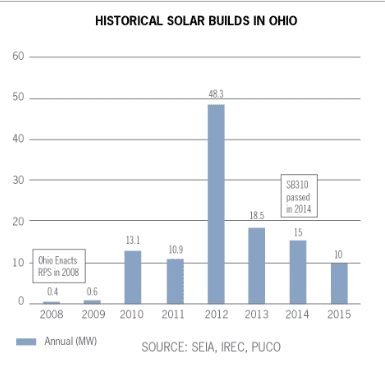The Ohio House of Representatives today voted 54-40 to devastate the state’s solar industry by increasing its renewable portfolio standards (RPS) — and the miniscule solar carve-out contained therein — at a snail’s pace through 2021.
Substitute House Bill 554 (HB 554) also allows the public utilities commission to define any future energy-resource as renewable, as well as turning the RPS into a voluntary program without any compliance obligations through 2021.
The effect of this bill on the solar industry in the state could be catastrophic. After Ohio became the first state in the nation to freeze its RPS in 2014 — with a solar carve-out of only 0.12 percent —solar installations fell from 15 to 10 MW, and most analysts expect those numbers to continue to drop.
Ohio’s historical solar-installation peak occurred in 2012, when the state 48.3 MW. HB 544 now goes to the Ohio Senate, where statehouse observers expect it to pass overwhelmingly.

“Ohio is falling steadily behind its neighbors in developing cleaner, cheaper sources of energy,” said Ted Ford, president of Ohio Advanced Energy Economy in a statement. “HB 544 continues the uncertainty that prevents businesses from being able to plan for investing in Ohio for the long-term.”
As more corporations increase their use of solar energy to reduce their carbon footprints and slash their electricity bills, legislation like HB 544 — which appears to have its origins in an American Legislative Exchange Council (ALEC) proposal — prevent companies from having stable renewable energy markets of which to avail themselves.
In 2016 Corporate Advanced Energy Commitments, the group Advanced Energy Economy reported that 71 of the Fortune 100 companies have set renewable energy or sustainability targets, up from 60 just two years ago.
The report also stated that among the Fortune 500, commitments have held steady at 43 percent, or 215 firms. Of these companies, 22 have committed to powering all of their operations with renewable energy. Most consider energy resources as they make location and expansion decisions.
This content is protected by copyright and may not be reused. If you want to cooperate with us and would like to reuse some of our content, please contact: editors@pv-magazine.com.








By submitting this form you agree to pv magazine using your data for the purposes of publishing your comment.
Your personal data will only be disclosed or otherwise transmitted to third parties for the purposes of spam filtering or if this is necessary for technical maintenance of the website. Any other transfer to third parties will not take place unless this is justified on the basis of applicable data protection regulations or if pv magazine is legally obliged to do so.
You may revoke this consent at any time with effect for the future, in which case your personal data will be deleted immediately. Otherwise, your data will be deleted if pv magazine has processed your request or the purpose of data storage is fulfilled.
Further information on data privacy can be found in our Data Protection Policy.